Spiders in Columbus, Ohio, have a very diverse area to call home. Columbus isn’t a quiet, small town, but it is filled with parks and museums. The Scioto Mile that runs on either side of the Scioto River is a vast park filled with trails and an interactive fountain. The Museum of Art is a breathtaking place, including a unique and fun sculpture garden, then on the west bank of the river is the COSI Science Center. No matter where you go in Columbus, there is plenty of beauty to take in, along with tons of fun things to do.
Since Columbus is such a diverse area for a spider, if you happened to be one, there would be unlimited places to call home. Parks running next to rivers are filled with insect life. With plenty of dinner options for a spider, the spiders can’t resist easy and moderately risky dining. Let’s take a look at a fraction of the cool spiders one might find in the city of Columbus.
Common Spiders
1. Bolas Spider (Mastophora hutchinsoni)

Female bolas spiders (
Mastophora hutchinsoni) have a unique way of attracting male moths.
©Christina Butler from Georgia, United States / CC BY 2.0 – License
Appearance: These are rare orb weavers that have large, round, irregularly shaped abdomens and small heads. They are light beige or white with brown growth-looking bumps on their back and chalky, marbling over the surface.
Size: Females are 10 – 20 mm, while the much smaller males are only 2 mm
Habitat: Plants, shrubs, trees or any foliage where they can sit and wait for a moth to come near the sticky ball.
Behavior: These interesting spiders do not make webs but instead make fishing lines with a sticky ball on the end that they use to catch insects. They produce pheromones mimicking a noctuid moth and once moths searching for a mate show up, the spider swings the sticky ball and catches the moth.
Dangers: None
2. Black and Yellow Garden Spider (Argiope aurantia)

Close-up of a black and yellow garden spider who is also lovingly referred to as the writing spider.
©Ron Rowan Photography/Shutterstock.com
Appearance: Long centimeter thick black and yellow striped body with very long spindly legs
Size: Females are .75 – 1.1 inches long with a leg span of 3 inches. The females are three times larger than the males.
Habitat: in between trees, bushes, shrubs, or in between plants in a garden.
Behavior: In the late night hours, the spider spins its intricate and large web, which it uses to catch bugs throughout the day. As evening falls, the spider eats her web and prepares to spin another one.
Dangers: None
3. Triangle Orbweaver (Verrucosa arenata)

Beautiful Triangle or Arrowhead Orbweaver (
Verrucosa arenata) quiet, undisturbed areas to make their webs.
©Christina Butler from Georgia, United States / CC BY 2.0 – License
Appearance: Triangular-shaped abdomens with a white, pink, or yellow arrowhead or triangle on their back. The rest of the spider is brownish-grey with stripes along its legs.
Size: Females are 1/4 inch long with a 3/4 inch leg span, while the males are much smaller.
Habitat: Gardens, shrubs, marshlands, wetlands, wooded areas
Behavior: These spiders have what looks to be icing on their backs with a zig zag design to make them appear larger to predators. They build new webs daily.
Dangers: None
4. Bowl and Doily Spider (Frontinella pyramitela)

Bowl and Doily Spider (
Frontinella communis) gets its name from the curved sheet, or bowl, it makes to capture insects and the flat sheet, or doily, under the bowl in which it sits waiting.
©Judy Gallagher / CC BY 2.0 – License
Appearance: Small reddish-brown spiders with white zigzags on their sides.
Size: Both males and females are 1/8 inch long with a 1/2 inch leg span
Habitat: Open fields and woodland edges
Behavior: The spider belongs to the sheet weaver family and lies underneath its sheet-like web and waits for prey to touch the web, where it bites through and captures the insect.
Dangers: None
5. Bull-Headed Sac Spider (Trachelas tranquillus)

Bull-headed Sac Spiders (
Trachelas tranquillus) have a bad habit of hiding in gloves.
©Judy Gallagher / CC BY 2.0 – License
Appearance: They look similar to the woodlouse spider but have eight eyes. They have a dark red cephalothorax and a pale cream-colored abdomen. Their body is similar in looks to a full tick.
Size: Females are 1/3 inch long, and the males are 1/4 inch long
Habitat: Rolled-up leaves on the forest floor, on fences, under rocks and boards.
Behavior: Also called the broad-faced spider, the bull-headed spider is a ground hunter feeding on dead insects, mites and other spiders.
Dangers: Painful bite similar to a bee sting. The bite can become very infected in children.
6. Clown-Faced Spider (Spintharus flavidus)
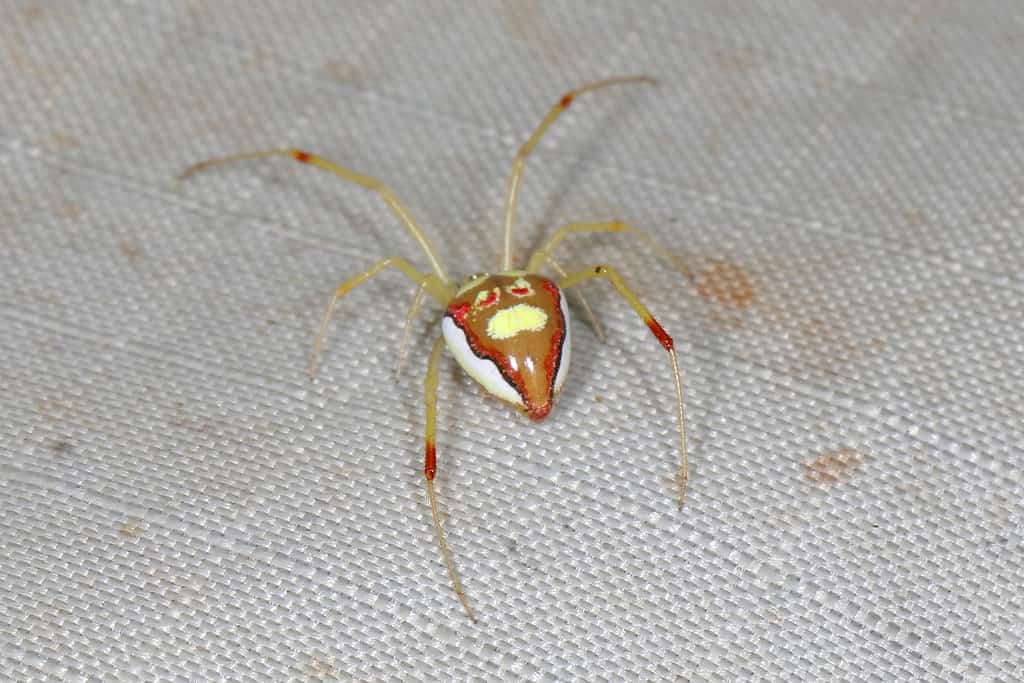
Clown-Faced Cobweb Spider (
Spintharus flavidus) are also called smiley-face spiders in the Caribbean.
©Judy Gallagher / CC BY 2.0 – License
Appearance: White-bodied spiders with long spindly legs unique to the cobweb spider species. There is a clown or smiley face design on their back, generally in the colors of light brown, red, and light yellow. The coloring can vary.
Size: Females are 4 – 6 mm, while males are 2.8 mm long
Habitat: Forest understory or beneath fallen leaves in the forest
Behavior: They make very small, sloppy webs and sit in them low to the ground facing downward where the glue droplets are that catch unsuspecting insects.
Dangers: None, timid spiders.
7. Zebra Jumping Spider (Salticus scenicus)
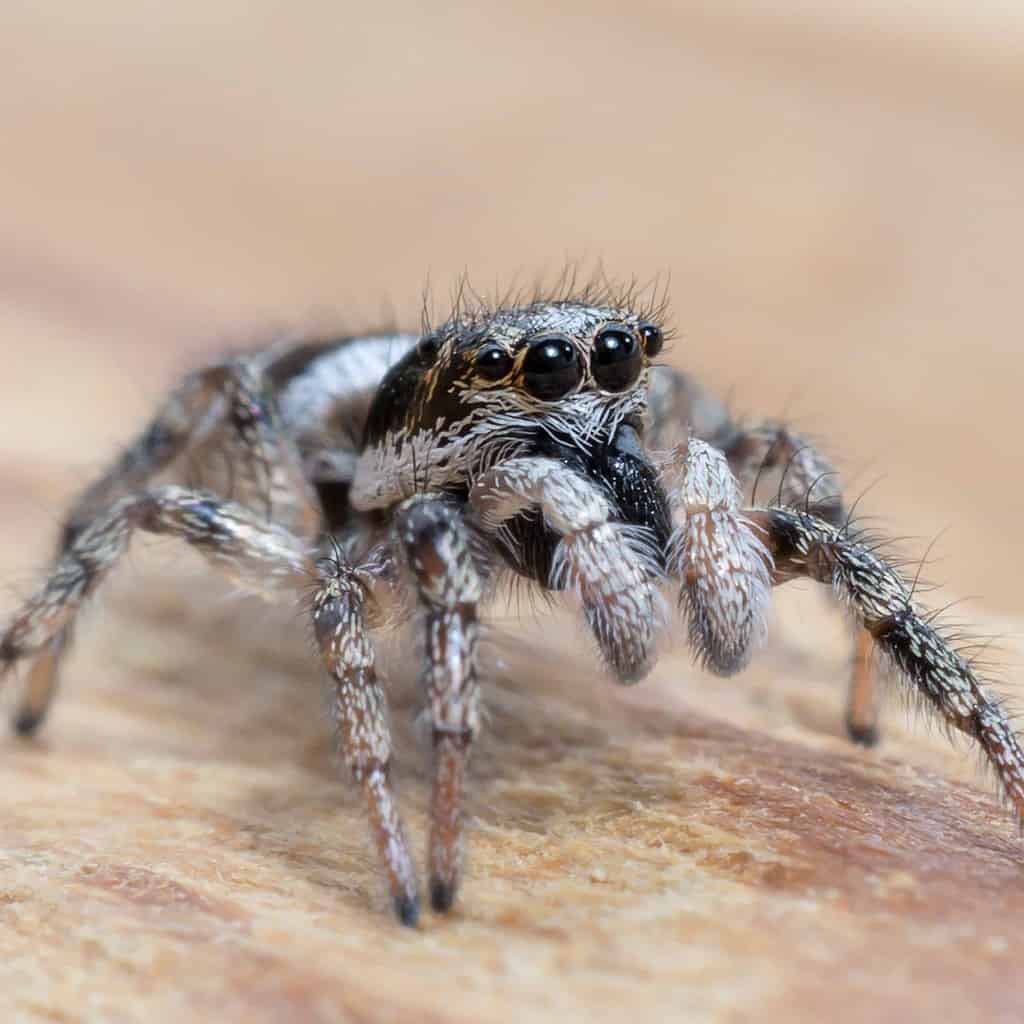
A zebra jumping spider is a great houseguest who will hunt mosquitos, flies, and small insects in your home.
©Photographer: Rabanser/Shutterstock.com
Appearance: Black and white striped body with fuzzy pedipalps and brightly colored chelicerae. Two large forward-facing eyes
Size: 1/8 – 1/2 inch long
Habitat: Trees, plants, flowers, gardens, walls, fences, and manmade structures.
Behavior: These tiny jumping spiders can jump over 10 times their body length and catch flies in mid-flight. They do not make webs except for the tiny hammocks they use as beds but hunt on foot.
Dangers: None
8. Hackled Mesh Weaver (Callobius bennetti)
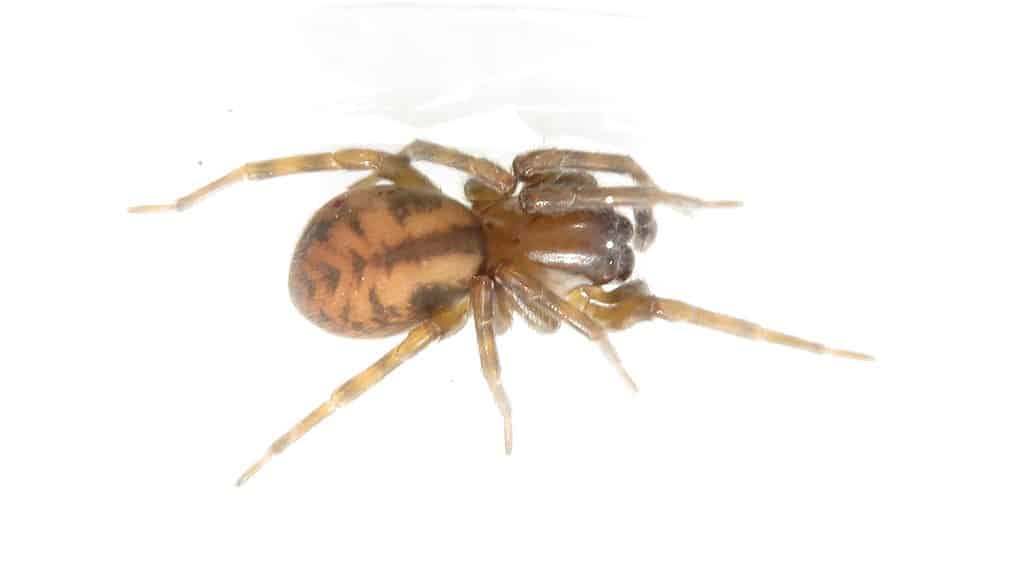
Hackled Mesh
Orb Weaver
(Callobius bennetti) creates unique-looking webs because their spinnerets are different that many other types of spiders.
©Dan MacNeal / CC BY 4.0 – License
Appearance: This spider is a heavy-bodied spider with short legs. Being brown and beige in color, the spider blends in well with the forest floor. It has light-colored chevrons along its back.
Size: Females are 1/3 of an inch long, while males are 1/4 of an inch long
Habitat: Under or around rocks, in wood piles, or in leaf litter on the forest floor.
Behavior: They make messy-looking webs, and this is due to them having a cribellum, which is a
type of spinneret where hundreds of very fine threads are produced at a time instead of one line.
Dangers: A very painful bite that can hurt for days. They are timid and tend to freeze when they see a human.
9. Filmy Dome Spider (Neriene radiate)
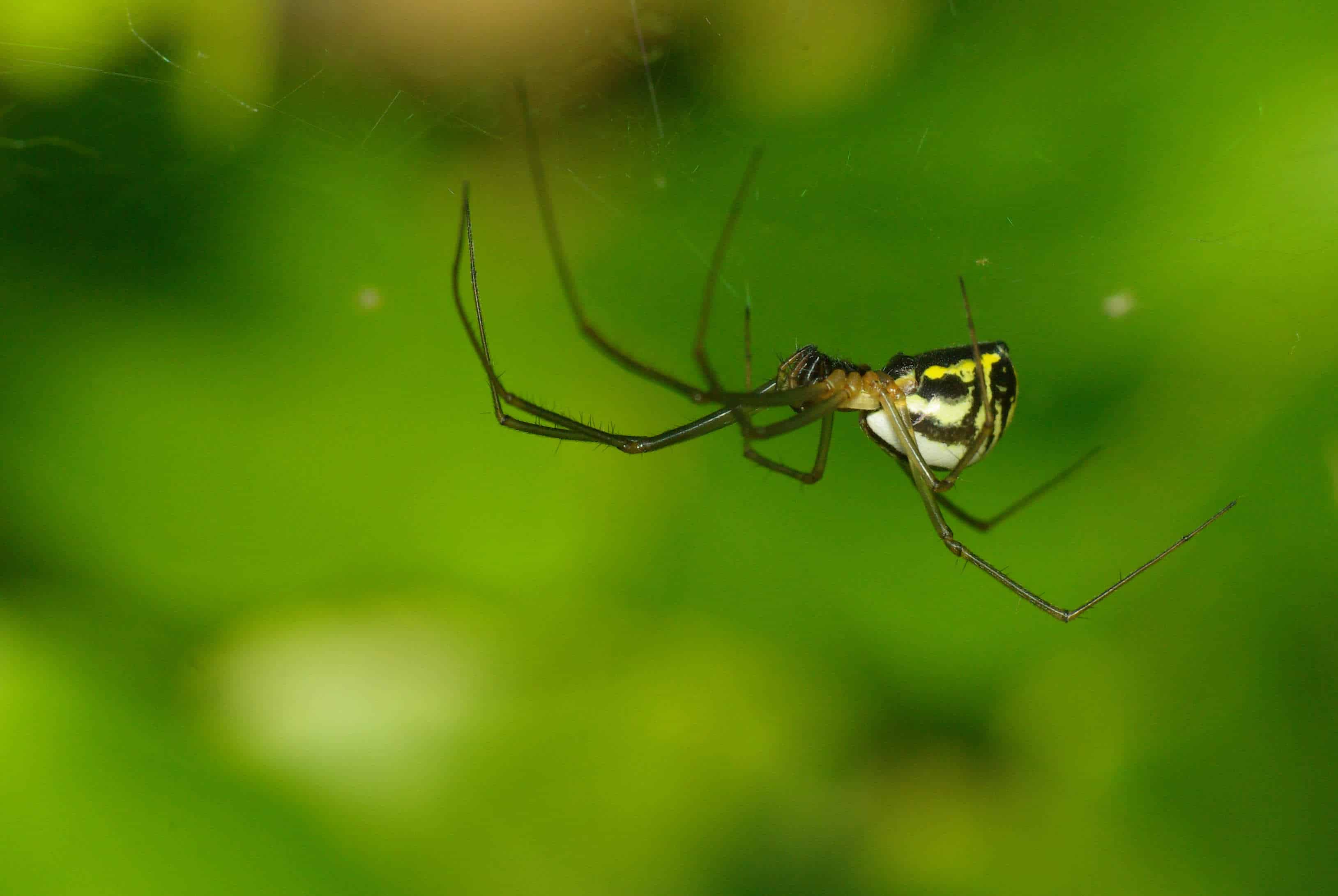
When the sun hits the dome-shaped web on dewy mornings, the dome refracts light which causes the illusion that nothing is lying wait under the dome because of its glittery appearance.
©DeRebus/Shutterstock.com
Appearance: It has a black or brown body with white or yellow stripes and flecks down the sides.
Size: Females are 1/4 inch long, with the males being smaller
Habitat: Forest floor, meadows, suburban gardens, and marshes.
Behavior: This sheet weaver constructs an upside-down bowl or dome shape with fine silk and lies in wait underneath to catch prey by biting through the webbing.
Dangers: None
10. Barn Orbweaver (Araneus cavaticus)
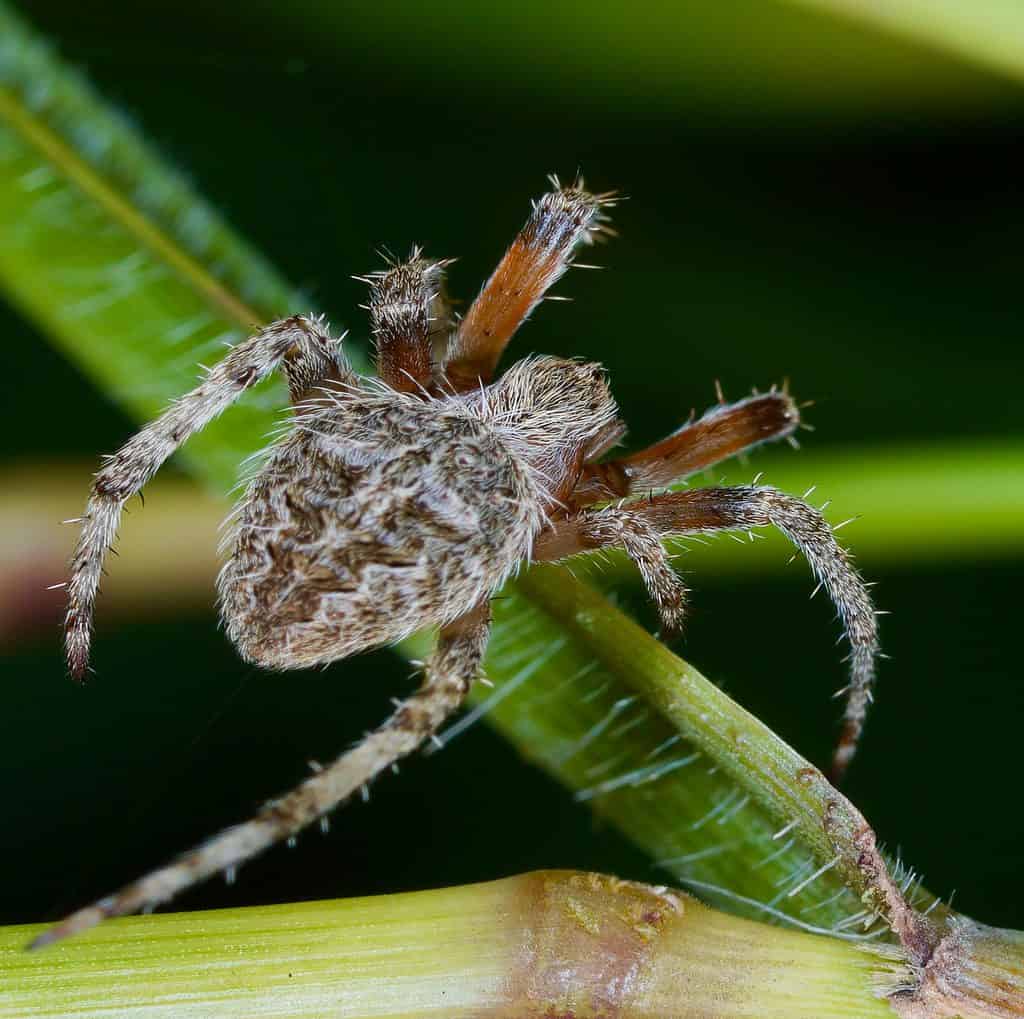
A barn spider,
(Araneus cavaticus), was made very famous by playing Charlotte on
Charlotte’s Web.
©Nadirsyah/Shutterstock.com
Appearance: Large round brownish body with faint beige or white markings on her back. Their two hind legs have white or beige stripes.
Size: The female’s body is roughly the size of a nickel up to a quarter or approximately 3/4 – 1 inch. The male is very tiny and does not look like the female, and is 1/8 inch long.
Habitat: Outdoor buildings, porch overhangs, forests, and suburban developments
Behavior: This nocturnal orb weaver spends its days resting up and makes a new web every night. In the morning, the large-bodied spider eats her web and hides for the day. They are smart and make intricate and very large webs near outdoor lights that attract insects at night. The male hangs out on the edge of her web, eating tiny insects she overlooks and attempting to creep up slowly and mate with her without being spotted and eaten first.
Dangers: None
11. Brush Legged Wolf Spider (Schizocosa ocreata)
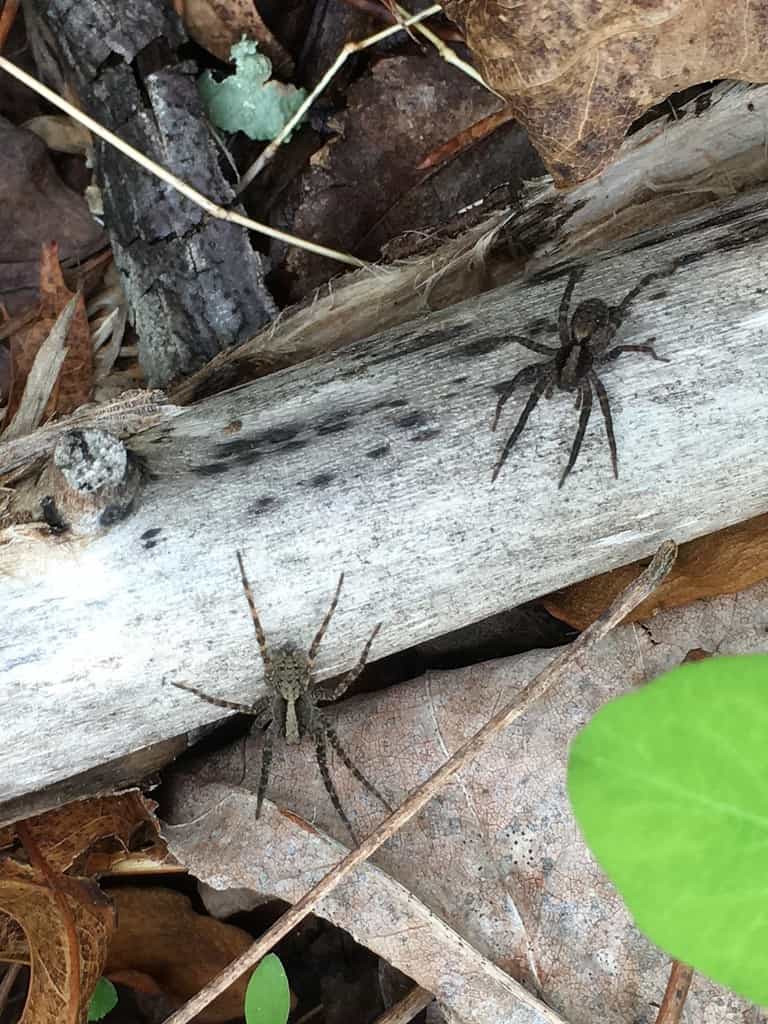
Brushed Leg
wolf spider
(
Schizocosa ocreata) males sometimes bite the female during forcible mating.
©Val (valehu) / CC BY 4.0 – License
Appearance: Furry legs, which are different than other wolf spiders, black or dark to light brown body with a beige or white colored stripe down the middle length of its body. On the abdomen, the stripe sometimes has ornamental designs in it that are brown.
Size: Females and males are both similar in size, .29 – .41 inches long.
Habitat: They can be found among wood, rocks or fallen leaves.
Behavior: These ground-dwelling nocturnal spiders are fast and hunt by stalking their prey on the forest floor.
Dangers: None
12. Grassland Crab Spider (Oxytate striatipes)

Grassland Crab Spider (
Oxytate striatipse) is one of the many spiders referred to as a green
crab spider
.
©池田正樹 (talk)masaki ikeda / CC BY-SA 3.0 – License
Appearance: Small, thin, bright lime green with long front sets of legs. The males are reddish colored.
Size: Males and females are near the same size, 9 – 12 mm.
Habitat: Grassy areas, forests, gardens, and suburban areas.
Behavior: These tiny green spiders stalk their prey on fences, trees, or on the ground.
Dangers: None
13. Red Banded Crab Spider (Misumenoides formosipes)
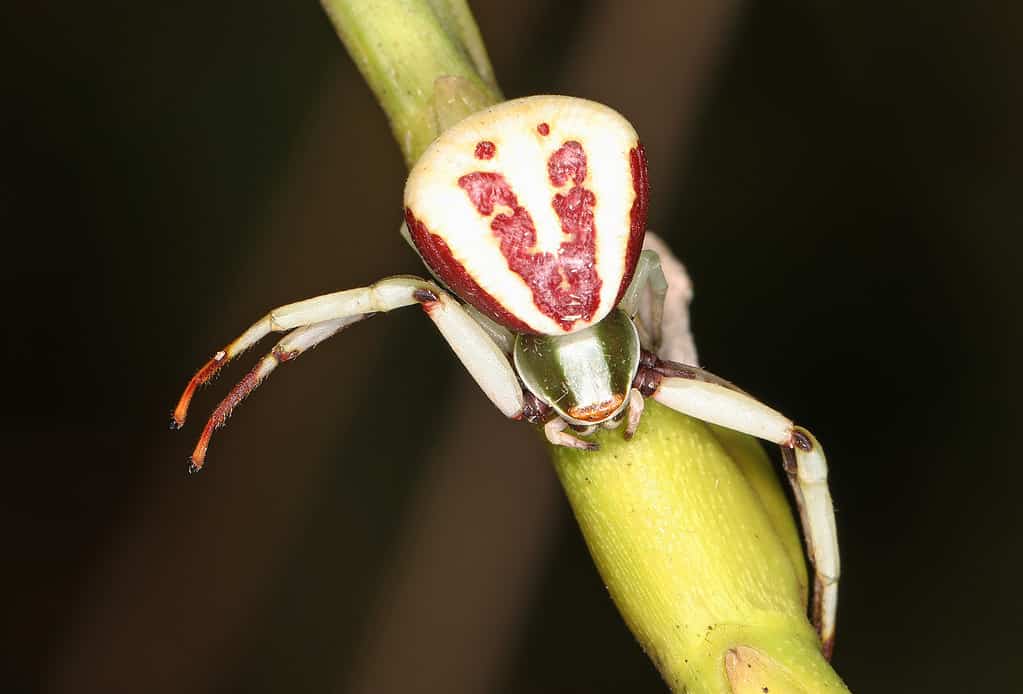
White or red-banded crab spiders (
Misumenoides formosipes) are one of the few spiders that can change colors, much like a
chameleon
.
©Judy Gallagher / CC BY 2.0 – License
Appearance: White or yellowish body with red markings along the sides and two red lines with dots at the ends on the upper abdomen. They can change their color to be white, beige, brown, or yellow depending upon the color of the flower they are hiding in. The males are smaller than the females and have yellow or amber-colored abdomen and reddish-colored legs.
Size: 5 – 11 mm long
Habitat: Inside of plants and flowers, and can change colors to match their environment in order to better sneak up on insects.
Behavior: These small crab spiders lay inside flowers and wait to ambush small insects and pollinators. The males will sometimes guard an immature female against other male suitors by basically moving in with her until she reaches maturity.
Dangers: None
14. Emerald Jumping Spider (Paraphidippus aurantius)
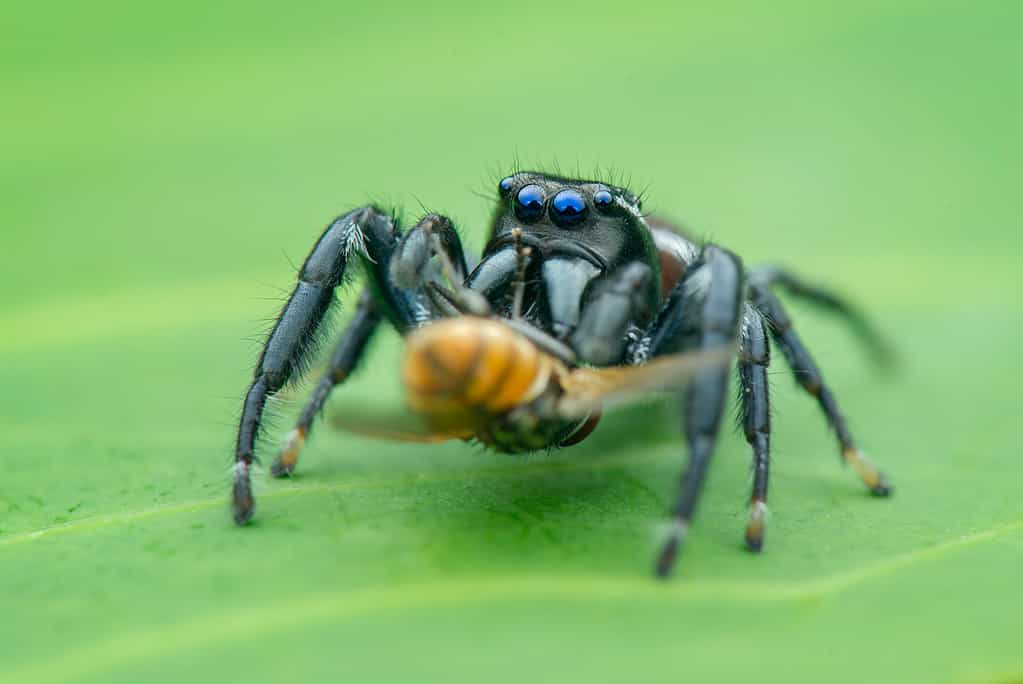
The male emerald jumping spider is born with dance moves he uses to woo his mate.
©DWI YULIANTO/Shutterstock.com
Appearance: Males are black with a white stripe on either side of their head and have a white stripe around their abdomens. The females are brown with orange details. Both sexes have a metallic green strip on their abdomen and cephalothorax that reflects in the light.
Size: 8 – 12 mm long, with the males being only slightly smaller.
Habitat: Trees, plants, manmade structures like fences, walls, and outdoor buildings.
Behavior: The jumping spider hunts on foot, with the females remaining near their hammocks and males tending to wander more. Both sexes use hammocks to molt and sleep. Male jumping spiders dance for the females to win them over.
Dangers: None.
15. Grass Spider (Agelenopsis pennsylvanica)
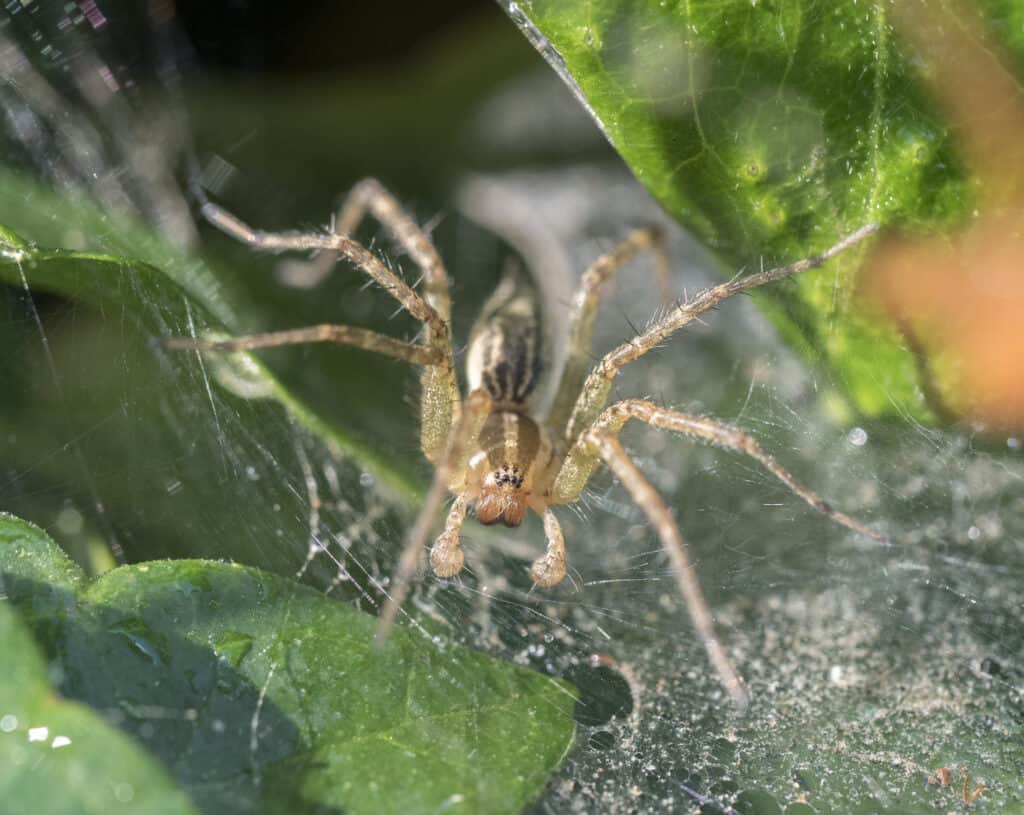
Funnel weaver spiders, or grass spiders, are very fast and rush out of their funnels to grab their prey.
©iStock.com/johnandersonphoto
Appearance: They are grey-brown with black or dark brown stripes on either side of their head and down their abdomen.
Size: 1/4 – 1/2 inch long with a leg span of 1 – 1.5 inches
Habitat: Found in sheet-like webs with funnels in the grass. They are also found on fences and outdoor equipment.
Behavior: They are voracious hunters who wait for their prey to step onto their flat sheet web before rushing out of their funnel and capturing them.
Dangers: Their bite can be painful, but they are otherwise harmless.
16. Folding Door Spider (Antrodiaetus lincolnianus)
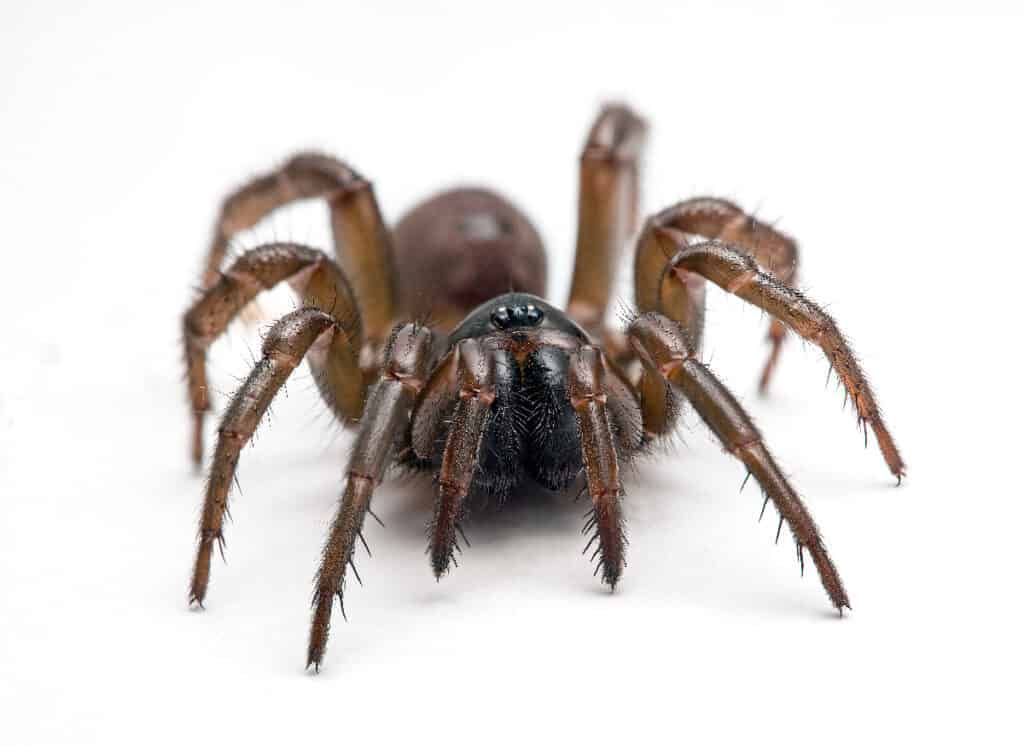
The folding door spider uses silk, vegetation, and soil to make the trap door on their funnel.
©Ernie Cooper/Shutterstock.com
Appearance: Reddish-brown in color that is very similar to most trapdoor spiders. They are stocky, thick-legged spiders with large fangs. They are part of a small atypical tarantula species.
Size: .13 – 1.13 inches long with a leg span of up to 1.5 inches.
Habitat: They live in silk-lined holes they dig in loose, moist soil that is reinforced with leaves and forest floor debris and have a trap door. They frequent cave entrances, bases of trees in moist forests, and near rock cliffs.
Behavior: Timid spiders that spend almost their entire lives in their funnels. When they are threatened, they tuck in their legs.
Dangers: They really do not bite unless you harass them. Their fangs are very small and will not pierce the skin of a human well. Their venom is harmless.
17. Long Jawed Orbweaver (Tetragnatha straminea)
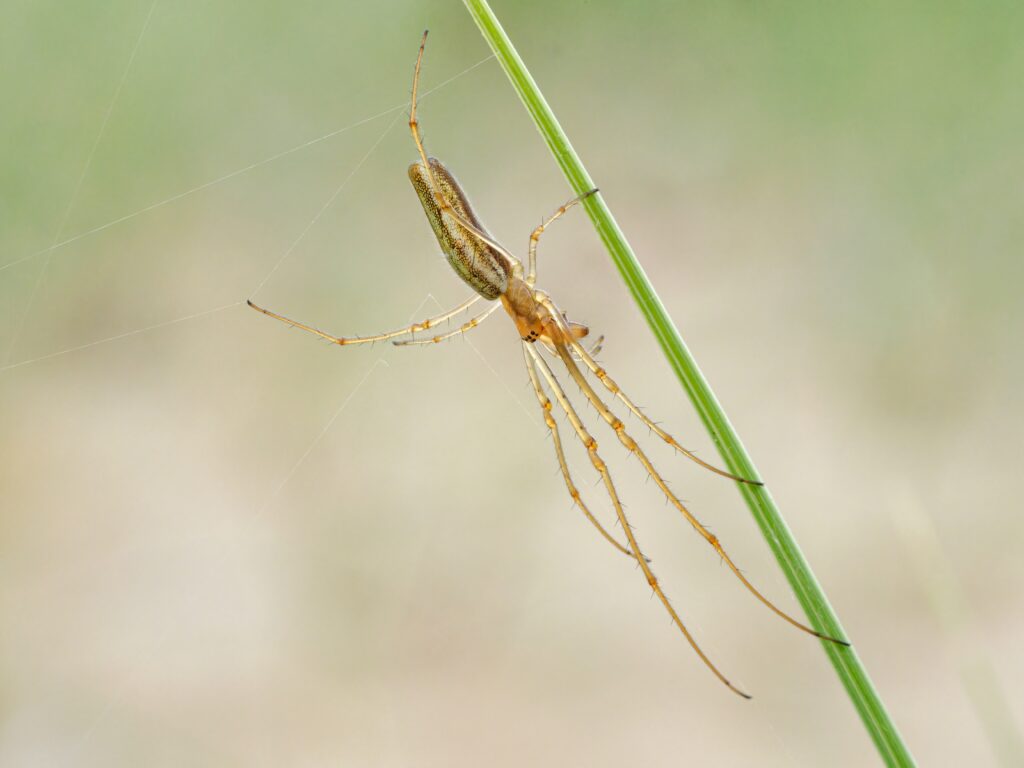
The long-jawed orb weaver is called such because of its large chelicerae, which can sometimes be longer than the spider’s cephalothorax.
©David Osborn/Shutterstock.com
Appearance: Very large chelicerae, long front legs, and tends to sit with its long front legs stretched in front of it. They have long slender bodies that come in many colors; brown, beige, grey, green, yellow, rust-colored, or tan, sometimes with designs on their back. The males are brown and much smaller and thinner than the females.
Size: Females are 1/2 inch long body with a legspan of 2 inches. The males are much smaller.
Habitat: Shrubs, tall plants, and bushes where it can stretch its horizontal web across.
Behavior: It leaves a hole in the web and holds on to the stalk of the plant or a branch, and as soon as it feels vibration, it descends to catch its victim.
Dangers: None.
18. Orchard Spider (Leucauge venusta)
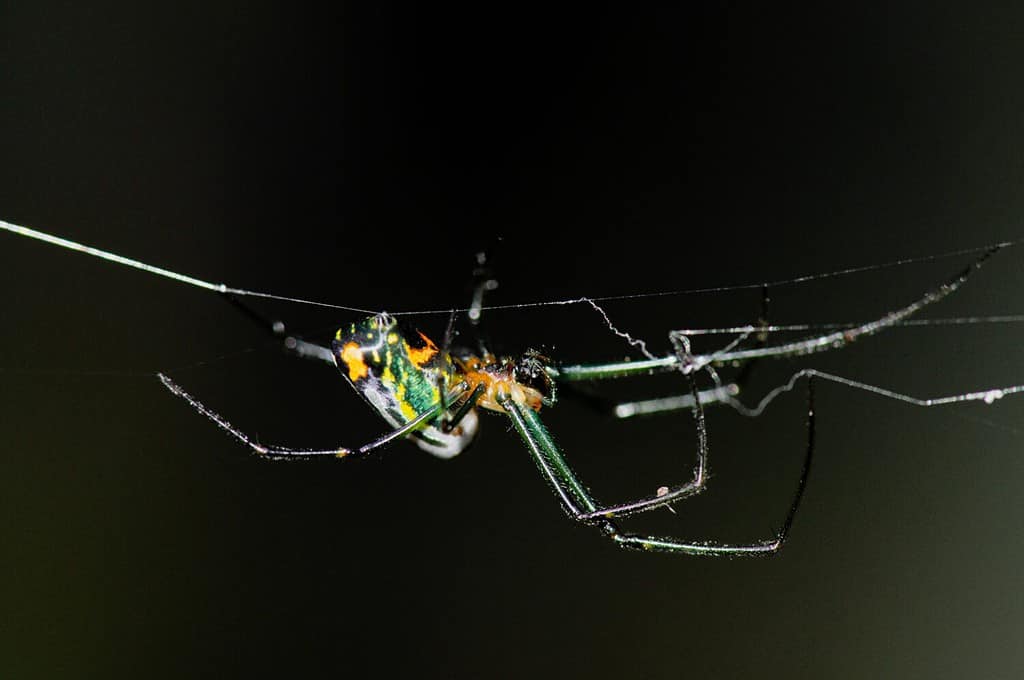
Orchard spiders are one of the most beautiful orb weavers with their bright rainbow coloring.
©Rogerio Peccioli/Shutterstock.com
Appearance: These spiders are very similar to long-jawed orb weavers in appearance but are brilliantly colored in blue, green, red, orange, and yellow. The underside is silvery with black stripes, and it is more apparent in the males.
Size: Females are .25 – .30 inches long with a leg span of 2 inches, while males are .13 inches long with a leg span of 3/4 inches.
Habitat: Apple orchards, woodlands, edges of forests, shrubs, and low-lying trees.
Behavior: They create large cartwheel-shaped webs that they rebuild daily. Since the males have fangs, they are generally not killed after mating and will defend themselves.
Dangers: None.
19. Pirate Wolf Spider (Pirata piraticus)

A pirate wolf spider, or the pirate otter spider, has water-repellant hairs on its legs.
©David James Chatterton/Shutterstock.com
Appearance: Similar to the usual wolf spider, but doesn’t have fur on its body. They are a chestnut red-brown with white on the sides of the abdomen and a mustard-colored mark on the upper abdomen.
Size: Females are .35 inches long with a leg span of 2.5 inches, while the males are only .24 inches long
Habitat: River backs, marshes, creeks, lakes, or anywhere that has a body of water.
Behavior: Hunts aquatic insects on the water and on the water’s edge. They do not build webs for catching prey and instead hunt their prey on foot.
Dangers: None.
20. American Nursery Web Spider (Pisaurina mira)
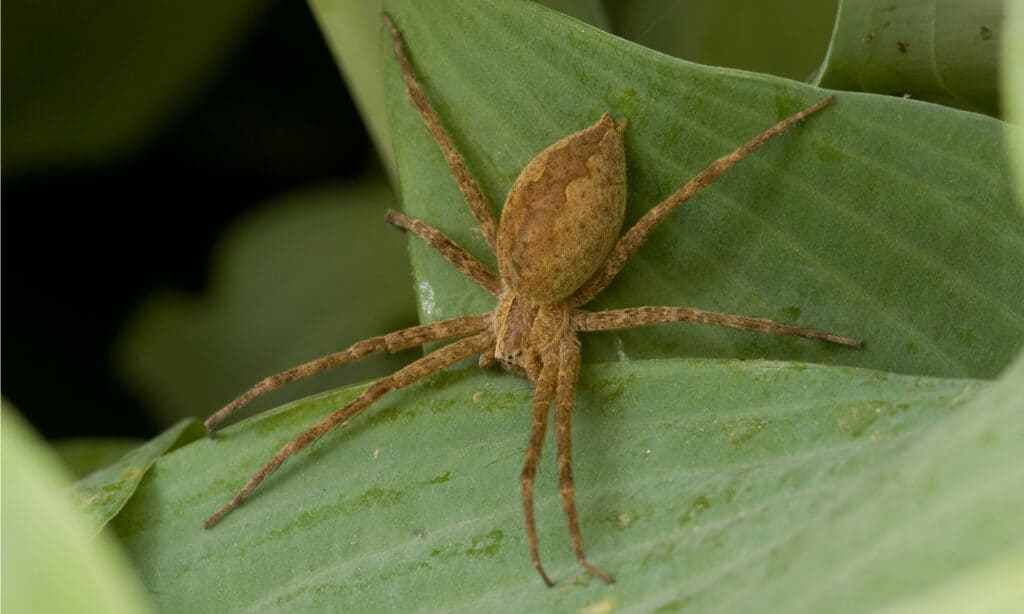
Male American nursery web or fishing spiders will tie females’ legs during mating to avoid being eaten afterward
©SDeming/Shutterstock.com
Appearance: This spider is distinguishable by its two front rows of eight eyes. They can be light brown, tan, greyish, or dark brown in color with a broad dark stripe down the center of their body.
Size: Females are .49 – .59 inches long with a leg span of nearly 2 inches, while the males are .35 – .59 inches long
Habitat: Docks, river banks, near creeks or other bodies of water, and nests in plant life found along the banks of water.
Behavior: The female suspends her egg sac in a triangular web right before the spiderlings hatch, which is why they are called nursery web spiders. The spiders are able to defend their young until they molt into large enough spiders to be on their own.
Dangers: None.
21. Spitting Spider (Scytodes thoracica)
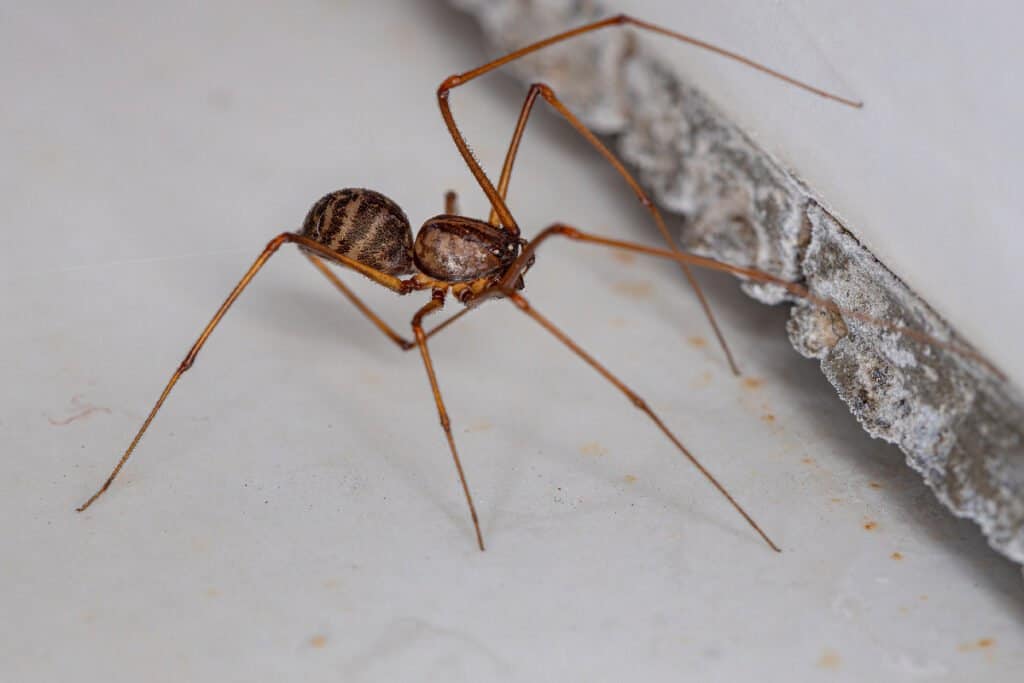
The brown spitting spider spits a venomous sticky silk-like substance all over their prey to incapacitate them.
©iStock.com/ViniSouza128
Appearance: Long, spindly legs, six eyes instead of eight, long two front legs, bright orange body with black stripes and dark patterns on its abdomen
Size: .12 – .24 inches long
Habitat: The nocturnal spider prefers warmth, so it is commonly found in homes. They also tend to hide under rocks.
Behavior: The spiders walk very slowly on their very long thin legs. They have poor eyesight, so they tap using their front legs around their prey until they find the perfect spot to spit strands of silk from its fangs, trapping its victim.
Dangers: None.
22. Tan Jumping Spider (Platycryptus undatus)
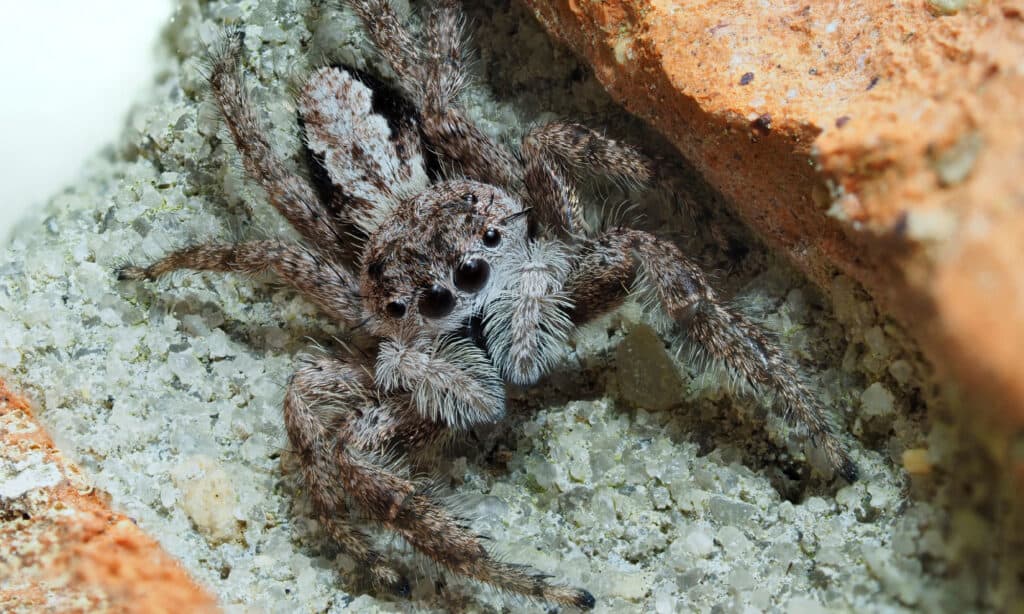
The tan jumping spider has keen eyesight and excellent jumping ability, which it uses to catch small insects in mid-flight.
©iStock.com/sdbower
Appearance: Small tannish-grey spiders with darker camouflaged markings on their body. They have brightly colored chelicerae and fluffy pedipalps.
Size: Females are .39 – .51 inches long with a leg span of .5 inch and the males are .33 – .37 inches long
Habitat: Fences, walls, manmade structures, trees, plants, and cars
Behavior: Inquisitive and charming but is also a vicious hunter by air and ground. They are able to jump over 10 times their size.
Dangers: None.
23. Black Lace Weaver (Amaurobius ferox)
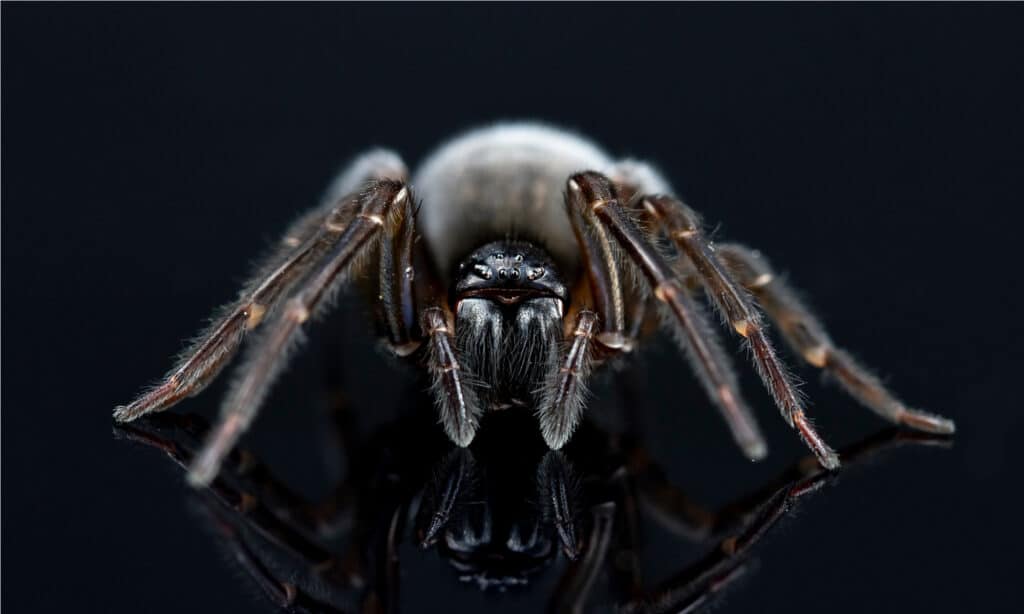
The black lace weaver mama performs the ultimate sacrifice for her spiderlings through matriphagous, which means the mother sacrifices herself as food for her spiderlings so that they can grow stronger before going out on their own.
©IanJHall/Shutterstock.com
Appearance: Dark colored, mostly very dark reddish-brown, almost black. It has very pale markings on its upper abdomen that look like a skull or ghoulish mask.
Size: Females are .62 inches long, while males are .47 inches long
Habitat: Under logs or rocks, sometimes in cellars and outdoor buildings. They are sometimes called old churchmen because they have been seen crawling on church walls and pews when it rains.
Behavior: These spiders are considered subsocial since the spiderlings stay together for about a month after cannibalizing their mother. They also share nests with other spiders and sometimes care for and feed young as a group. The mother lays infertile eggs for the tiny spiderlings to eat until they are big enough that she sacrifices herself.
Dangers: None.
24. Tiger Wolf Spider (Tigrosa aspersa)
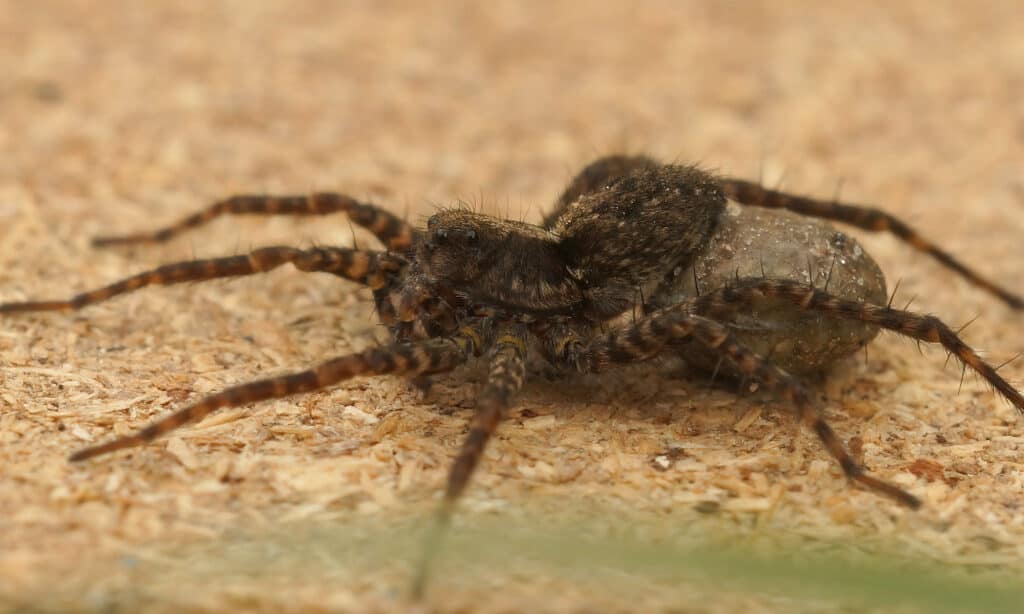
The
tiger
wolf spider is also known as the speckled wolf spider or woodland giant wolf spider
©HWall/Shutterstock.com
Appearance: This spider is furry and brown with yellow hairs on its carapace near the eyes. Black spots on the underside of the abdomen are what separates this spider from other wolf spiders.
Size: Females are around .67 – 1.31 inches long, while males are .43 – .94 inches long.
Habitat: Forests, woodland areas, fields, yards, meadows and marshes
Behavior: This nocturnal spider hunts on foot and does not make a web for catching insects. Wolf spiders are known to eat other, more dangerous spiders like brown recluses and black widows.
Dangers: None.
25. Barn Funnel Weaver (Tegenaria domestic)
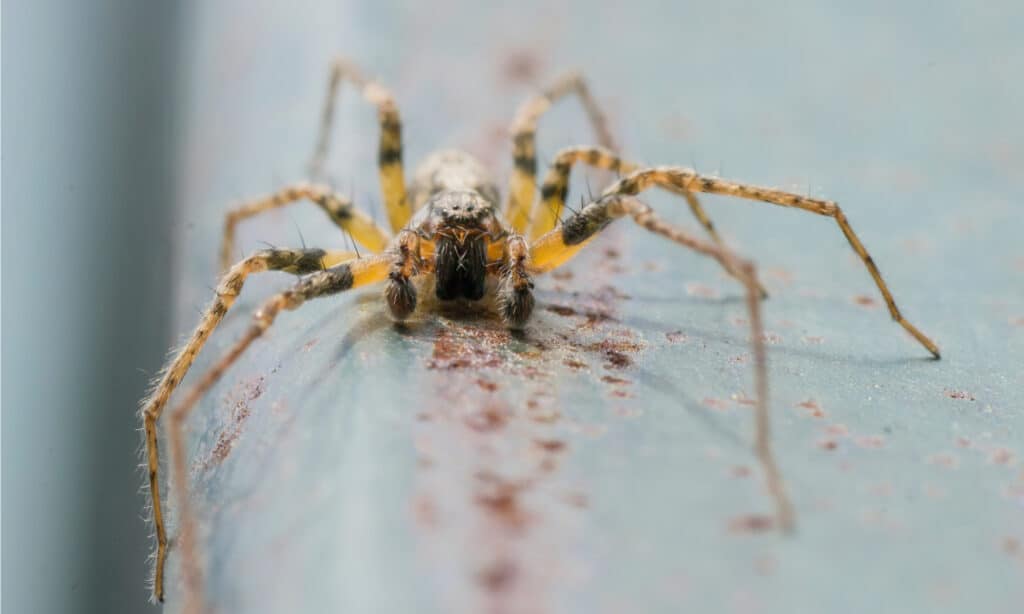
The barn funnel weaver is photosensitive and will move when in direct light.
©Korovko Gleb/Shutterstock.com
Appearance: They are dark orange, beige, brown or grey. They have striped legs and two soft black lines on their cephalothorax. The abdomen has mottled brown, yellow, and grey chevron designs that look like an argyle pattern.
Size: Females are .30 – .49 inches long, while males are .24 – .35 inches long.
Habitat: Under rocks and boards, in wood piles, barns, homes, sheds, garages, and cracks in rock faces.
Behavior: These spiders can live up to 7 years. They build funnels that lead into a small sheltered place where they remain until an insect has stepped into the funnel.
Dangers: None. Cannot break the skin.
Dangerous Spiders
26. Yellow Sac Spider (Cheiracanthium inclusum)

Yellow Sac spider (Cheiracanthium) with prey in a pine tree. These dangerous spiders are prolific at night, and have similar venom to the Brown Recluse spider, only a milder dose.
©Brett Hondow/Shutterstock.com
Appearance: Light yellow to beige with dark reddish brown chelicerae and feet.
Size: Both sexes are approximately the same size of .20 – .39 inches long.
Habitat: Gardens, bushes, trees, leaf litter, forest floors, trees
Behavior: These spiders are nocturnal hunters that do so on foot and do not make a web. Most of the bites inflicted upon humans happen because the spider is in clothing or bedding and gets pinned up against the skin.
Dangers: Their bite is painful as the cytotoxic venom begins to work through your system. Neurotoxic venom is stronger. At first, the bite is similar to a mosquito bite, but as time passes, the bite becomes more painful with burning and swelling and can lead very rarely to mild necrosis of the skin.
27. Mediterranean Recluse (Loxosceles rufescens)

The Mediterranean recluse is a cave-dwelling spider.
©Macrolife/Shutterstock.com
Appearance: They look almost identical to the brown recluse though these originated in the Mediterranean and tend to live in caves. The violin shape at the top of its cephalothorax is there, just like on the brown recluse.
Size: .25 inches long with a leg span of
Habitat: Caves, basements, and tunnels
Behavior: They are nocturnal hunters, doing so on foot and hunting silverfish, roaches, and small insects. They spin very small, sloppy webs that they use for sleeping and egg sacs.
Dangers: Similar to the brown recluse, this spider injects a cell-destroying venom that is not felt at first but after 2 – 8 hours because very painful and swollen. It can become necrotic like the brown recluse’s bite, though it is milder. The center of the bite will deflate and become dark blue first. In rare cases, hemolysis, intravascular coagulation, and thrombocytopenia can occur, leading to renal failure.
28. Northern Black Widow (Latrodectus various)
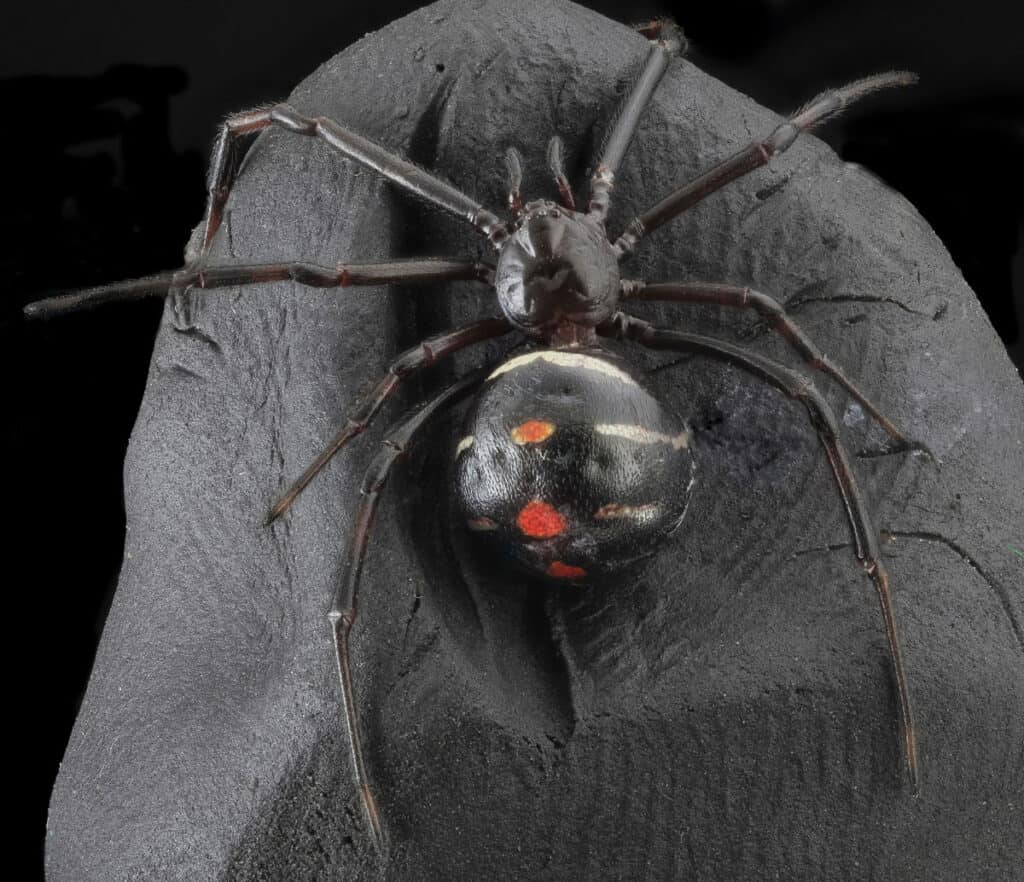
There are several different types of widow spiders in the world.
©Porco_Rosso/Shutterstock.com
Appearance: A black pea-sized spider with two red spots on the underside of its abdomen. This is referred to as a broken hourglass and is sometimes missing the middle section, and other times it appears just as two red dots. The males have brown legs and have sets of white bands along each side of their abdomen. Juveniles of both sexes can have white banding.
Size: Females are .31 – .5 inches long with a leg span of 1 – 1.37 inches long. The males are .11 – .4 inches long with a leg span of .51 inches.
Habitat: Manmade structures like houses, garages, attics, walls, cabinets, wood piles, playhouses, boxes, and outdoor toy bins. They are very timid and stay hidden almost always.
Behavior: Because of their timid disposition, the spiders stay hidden in crevices or small undisturbed spaces most of the time. They make small, sloppy cobweb spiderwebs for catching small insects.
Dangers: There is less than 1% mortality of people bitten, and those are generally small children. The female spider releases a neurotoxic venom when she bites. The amount of toxin varies depending on when she last used it. The venom of a black widow is 15 times stronger than rattlesnake venom. The bite causes severe pain, swelling, severe cramping, fever, nausea, sweating, and chills, just to name a few. However, even if a typical person doesn’t seek antivenom or medical attention, the bite typically goes away in a few days. The pain and other negative symptoms will last that long without antivenom if the spider releases a big load of venom in her bite.
29. Southern Black Widow (Latrodectus mactans)
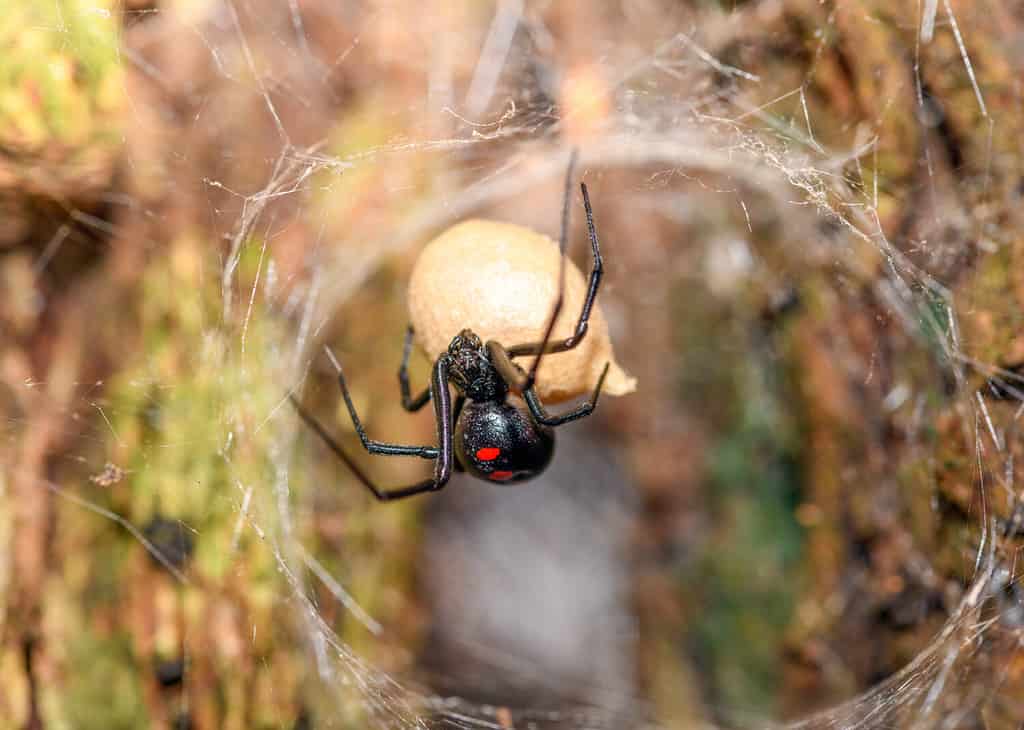
Southern black widows are slightly larger than northern black widows.
©Jeff W. Jarrett/Shutterstock.com
Appearance: A black pea-sized spider with an hourglass marking on the underside of its abdomen. Males do not have the hourglass shape but can have red spots on the underside of their abdomen.
Size: Females are .5 inches long and up to 1.47 – 1.9 inches with a leg span, while males are .23 inches long with a leg span of .39 inches.
Habitat: Manmade structures like houses, garages, attics, walls, cabinets, wood piles, playhouses, boxes, and outdoor toy bins.
Behavior: They are very timid and stay hidden almost always.
Dangers: There is less than 1% mortality of people bitten, and those are generally small children. Approximately 2,500 people visit emergency centers every year with black widow bites and are treated with antivenom. Without the antivenom, the side effects will last several days. Since the black widow’s bite releases neurotoxic venom, it causes systemic effects like severe pain, nausea, chills, profuse sweating, fever, severe muscle cramping, and more. If not treated with antivenom, the person generally recovers in a couple of days unless they are very young, old, or have a severely compromised immune system.
30. Brown Recluse (Loxosceles reclusa)
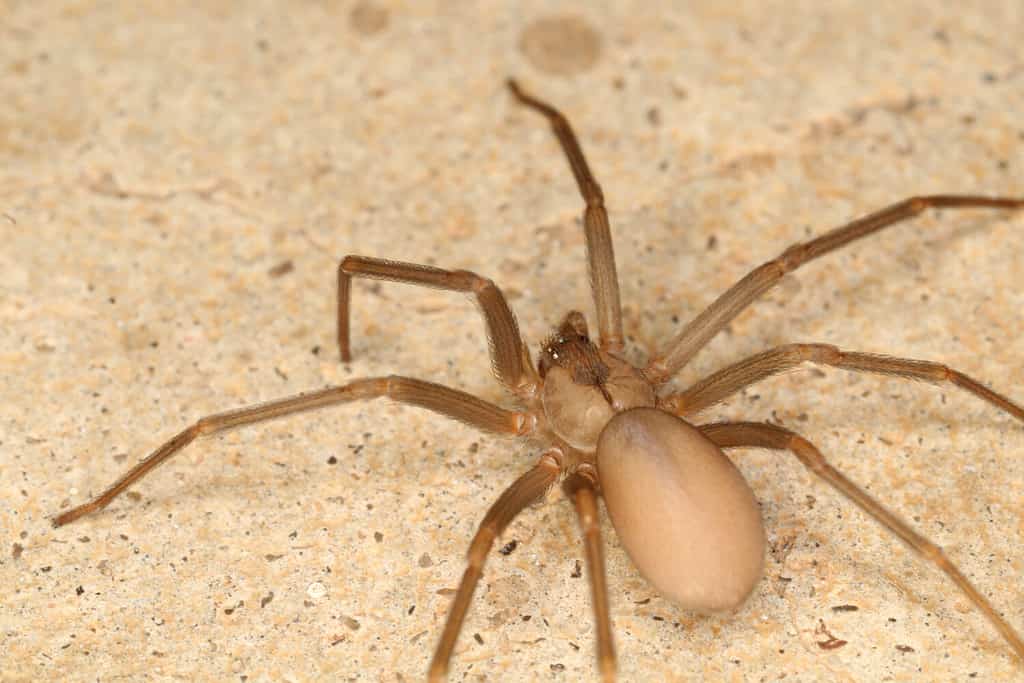
©Nick626/Shutterstock.com
Appearance: Darker brown legs and violin shape on the head area of the cephalothorax. The violin’s neck points towards its rear end. The cephalothorax is round and light brown or beige, like the abdomen. They have very fine hairs on their legs. They also only have six eyes as opposed to the eight of most other spiders.
Size: 1/4 – 1/2 inches long and a 1 inch leg span
Habitat: Gaps under boards, wood piles, rocks, leaf litter, or other first debris. They are also found in outdoor buildings, in boxes, or other small spaces without human traffic. They are not found throughout the country and are mostly in the central states.
Behavior: They are nocturnal hunters that do so on foot without the assistance of a web. They are known to be cannibalistic and to also eat dead insects.
Dangers: They are very timid spiders and bite only as a last resort.
The photo featured at the top of this post is © Judy Gallagher / CC BY 2.0 – License
Thank you for reading! Have some feedback for us? Contact the AZ Animals editorial team.






